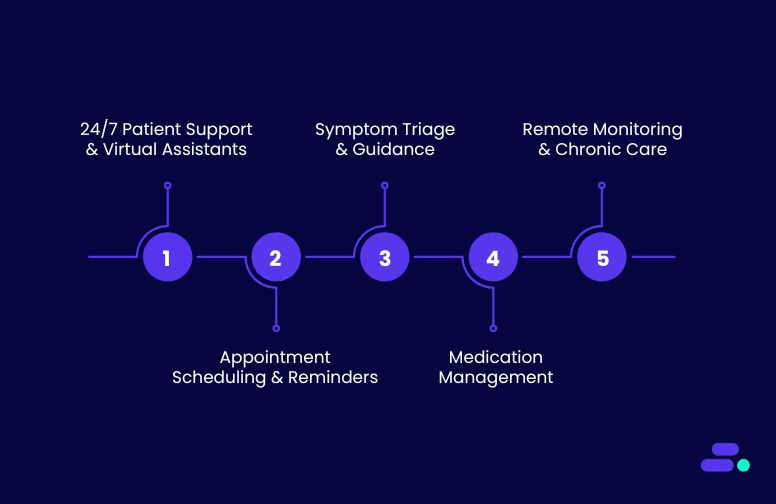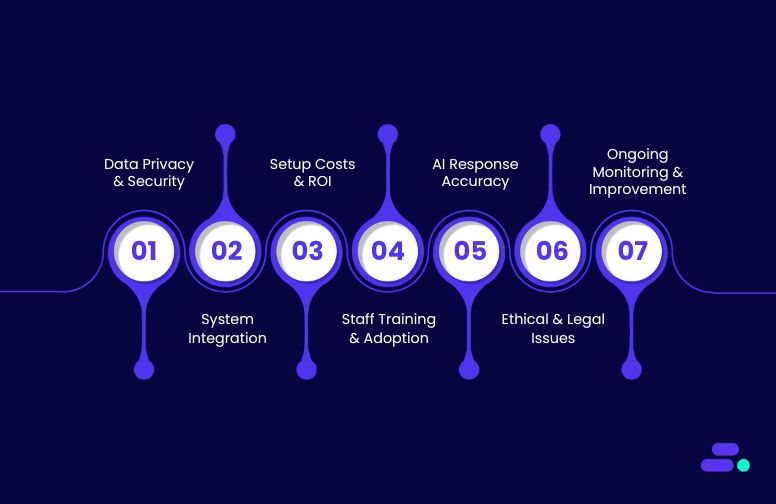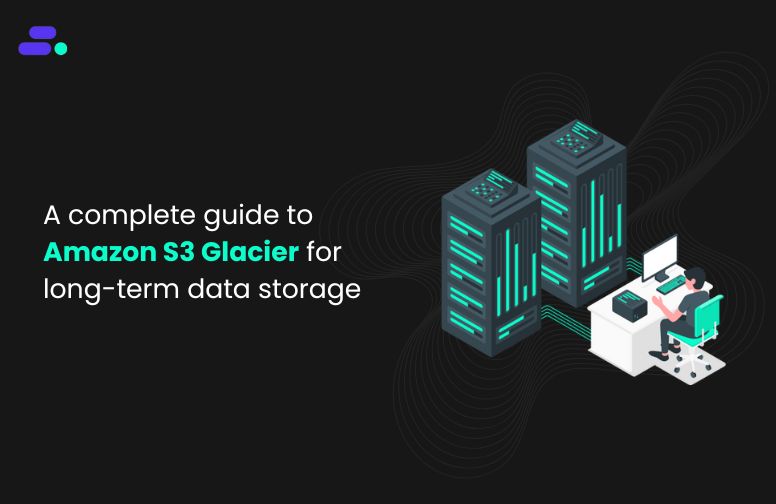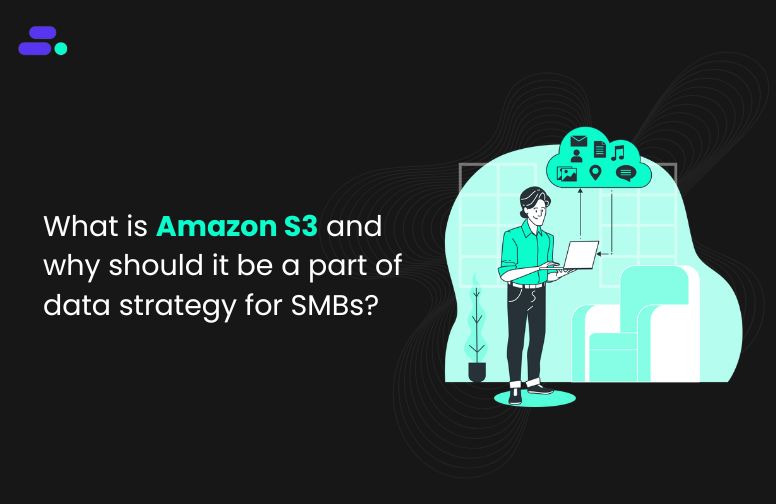This is a div block with a Webflow interaction that will be triggered when the heading is in the view.

Modernize your cloud. Maximize business impact.
Serverless architecture is a cloud-native model where developers build and run applications without managing servers. Instead of provisioning or maintaining infrastructure, services like AWS Lambda automatically execute code in response to events and scale based on real-time demand. This frees up time and resources, making it especially valuable for small and medium-sized businesses (SMBs).
For example, a healthcare SMB can use AWS Lambda, API Gateway, and Amazon S3 to build a serverless patient intake system that handles forms, stores records, and sends notifications, without managing servers. This cuts infrastructure costs by over 60%, boosts data availability, and simplifies HIPAA compliance, letting teams focus on care, not maintenance.
This article walks through the fundamentals behind serverless architecture, the AWS services enabling it, and how it empowers SMBs to innovate efficiently and securely.
Key takeaways:
- Serverless cloud computing runs code on AWS with no servers to manage, billing only for actual execution.
- Core stack: event‑driven functions (FaaS), managed back‑end services (BaaS), and auto‑scaling data pipelines that link front‑end and back‑end.
- Best suited to bursty or asynchronous workloads like APIs, ETL, real‑time analytics, and IoT, where SMBs need quick releases and minimal ops overhead.
- Key trade‑offs like cold‑start delays, runtime limits, monitoring complexity, and potential vendor lock‑in are mitigated by least‑privilege IAM, encrypted data, and robust observability.
- Cloudtech guides SMBs through a five‑phase AWS roadmap, delivering secure pipelines, compliant data lakes, and GenAI‑ready foundations.
How does serverless architecture work? A simple breakdown
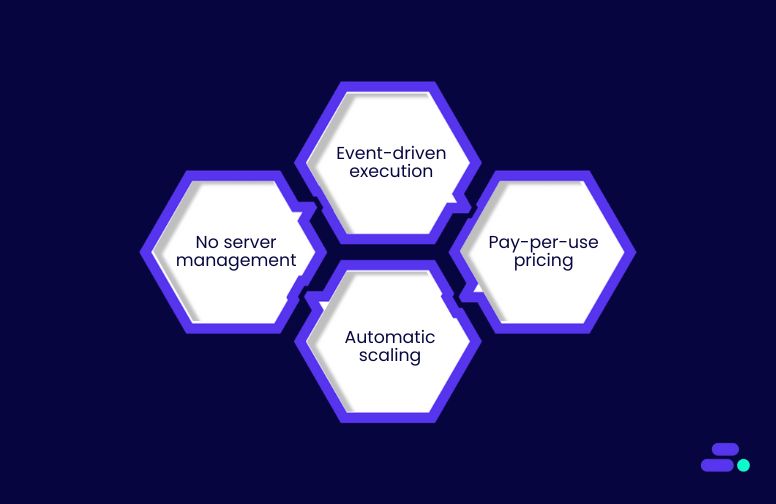
Serverless architecture is a cloud-native model where the cloud provider (like AWS) automatically manages the infrastructure. Instead of provisioning servers, scaling compute, or handling maintenance tasks, developers simply write and deploy code. Serverless apps are built to run inside short-lived, stateless containers such as AWS Lambda, which are triggered by specific events and shut down after execution.
Unlike traditional apps that run continuously, serverless apps execute only when needed, like when a user makes a request or a file is uploaded. This event-driven, on-demand execution model helps SMBs stay lean and agile, eliminating idle resource costs and manual scaling.
The key characteristics of serverless apps include:
- No server management: All infrastructure is managed by the cloud provider
- Event-driven execution: Code runs only in response to specific triggers
- Automatic scaling: Resources scale up or down with workload changes
- Pay-per-use pricing: SMBs charged only for actual compute time used
This model significantly benefits SMBs by speeding up development, reducing operational burden, and aligning cloud costs directly with usage.
Serverless also simplifies how frontends and backends interact. Web and mobile apps can invoke backend functions directly through services like Amazon API Gateway, enabling real-time communication without the need for persistent server infrastructure. These backend functions, running on AWS Lambda, can process data, call APIs, or store outputs in services like Amazon S3 or DynamoDB, all without manual scaling or server setup.
There are multiple types of serverless computing that serve different layers of the application stack. Each plays a distinct role in simplifying development and reducing infrastructure management:
- Function-as-a-Service (FaaS): Runs discrete, event-driven functions without persistent infrastructure. (e.g., AWS Lambda)
- Backend-as-a-Service (BaaS): Offers managed services for common backend needs like auth, storage, and databases. (e.g., Amazon Cognito, AWS Amplify)
- Serverless databases: Scale automatically and require no server maintenance. (e.g., Amazon DynamoDB, Aurora Serverless)
- Serverless containers: Containers that run and scale without manual provisioning. (e.g., AWS Fargate)
- Serverless edge computing: Executes functions closer to users to reduce latency. (e.g., AWS Lambda@Edge)
To see where FaaS fits within the broader cloud landscape, it helps to compare it with other service models. FaaS offers maximum abstraction, where developers write only the function logic, and the cloud handles the rest. Other models offer varying levels of control and responsibility:
Combining the right serverless components allows SMBs to reduce complexity, scale on demand, and build modern applications faster, all while keeping costs predictable and operations lightweight.

How can SMBs run applications on serverless architecture?
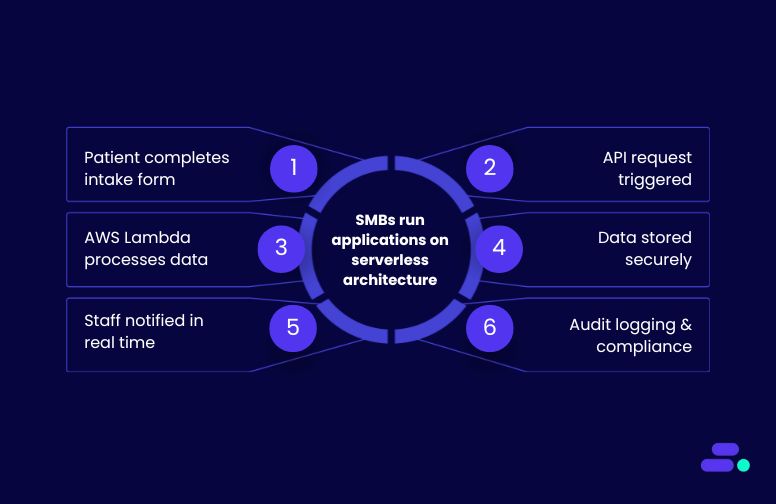
Serverless apps run in response to events, like form submissions or file uploads, using managed cloud services. Instead of operating on always-on servers, each component executes on demand, scales automatically, and requires no infrastructure management. Services like AWS Lambda, API Gateway, and DynamoDB handle compute, APIs, and data, so developers can focus on functionality, not infrastructure.
Consider a healthcare SMB modernizing its patient intake process. Using AWS serverless tools, it builds an app that collects patient data online, validates it, stores it securely, notifies staff in real time, and logs activity for compliance, all without managing a single server.
Step 1: Patient fills out the online intake form
The journey begins when a patient opens the clinic’s website or mobile app to complete a digital intake form. The form collects essential details like name, symptoms, insurance info, and optional document uploads.
The frontend of the application is serverless and static, hosted on:
- AWS Amplify for rapid development and deployment of web/mobile apps
- Or Amazon S3 with CloudFront for secure, low-latency static hosting
All content is served via a global CDN, ensuring speed and availability across regions. The serverless frontend allows instant scaling and simplified deployment without maintaining web servers.
Step 2: Form submission triggers an API request
When the patient submits the form, the data is sent to the backend using HTTPS. But instead of routing to a traditional server, the request is handled by a serverless API endpoint.
Amazon API Gateway acts as the secure entry point:
- It accepts, validates, and routes incoming API calls
- It supports throttling, authentication (e.g., via Amazon Cognito), and monitoring
- It integrates directly with AWS Lambda without requiring server infrastructure
API Gateway offloads the complexity of managing and securing APIs, helping SMBs launch secure backends faster.
Step 3: AWS Lambda processes the incoming data
The API call triggers a Lambda function, which contains the core logic for processing the patient submission. The function performs multiple tasks in milliseconds:
- Validates input (e.g., required fields, data types, document size)
- Performs lightweight logic (e.g., checking symptom severity, tagging high-priority cases)
- Formats data for storage or additional processing
- Lambda runs in an isolated, ephemeral container, spinning up only when triggered and shutting down after execution
- It scales automatically per request, ensuring zero performance lag under load
Lambda allows SMBs to run secure, scalable backend logic without provisioning compute infrastructure.
Step 4: Data is stored in secure, scalable storage
Once validated, patient information and documents need to be stored securely for later retrieval and processing.
Amazon DynamoDB is used for storing structured data:
- Patient name, symptoms, contact info, and form metadata
- Fast, scalable NoSQL database with automatic scaling and low-latency performance
- Supports fine-grained access control and encryption at rest
Amazon S3 stores unstructured data like:
- Uploaded documents (insurance cards, test results)
- Each file can be encrypted using SSE-S3 or SSE-KMS for HIPAA-compliant storage
These services offer scalable, pay-as-you-go storage that complies with healthcare data regulations and eliminates the need for physical servers or database licenses.
Step 5: Clinic staff is notified in real time
Once the form is submitted and data is stored, the system triggers a notification to the clinic’s admin or triage team.
A second Lambda function or AWS Step Functions orchestrates the post-submission flow:
- Determines priority based on patient symptoms
- Sends alerts via Amazon SNS (email or SMS) or posts to a Slack channel
- Optionally logs an entry into a clinic-facing dashboard using a service like Amazon AppSync (GraphQL-based real-time API)
Real-time communication ensures clinics can act on urgent cases immediately, improving patient outcomes and operational efficiency.
Step 6: Audit logging and compliance
Every API call, function execution, and data access is logged for auditing and compliance, which is crucial in healthcare where regulations like HIPAA require full traceability.
Amazon CloudWatch captures:
- Lambda invocation logs, function errors, and performance metrics
- Alarms can be set for anomalies or failures
AWS CloudTrail tracks:
- API Gateway calls
- IAM usage and access events
- Data changes or actions performed by clinic staff or applications
Built-in logging and audit trails help SMBs meet regulatory obligations without building custom monitoring systems.
By using AWS serverless tools, the healthcare SMB builds a scalable, secure, and event-driven patient intake system that:
- Launches faster than traditional web apps
- Costs less to run and maintain
- Automatically adapts to traffic spikes (e.g., flu season or viral outbreak)
- Provides a seamless, responsive experience for patients
- Keeps operations compliant without a dedicated DevOps team
This allows them to outpace competitors who are stuck in legacy hosting models, enabling rapid innovation, real-time care delivery, and higher patient satisfaction.
Also Read: Building Modern Data Streaming Architecture on AWS
5 ways serverless helps SMBs outpace competitors
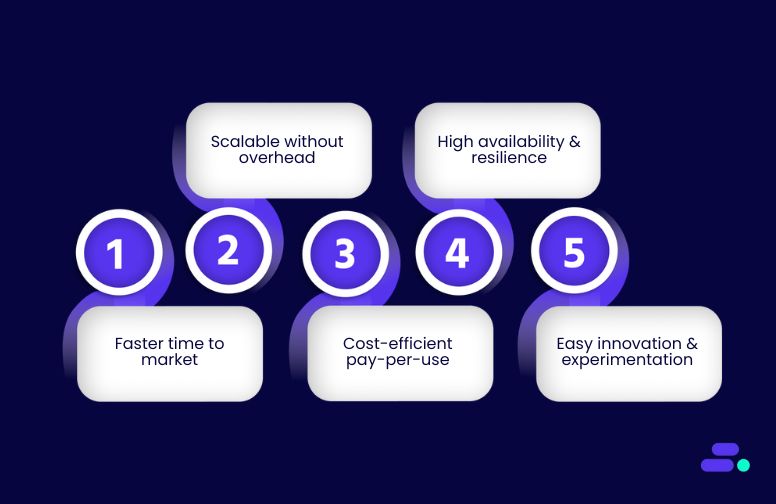
SMBs can’t afford to be slowed down by traditional infrastructure models. Serverless architecture offers them a strategic edge, leveling the playing field with enterprise-grade scalability, agility, and efficiency, all without the heavy investment.
Serverless architecture helps SMBs move faster, do more with less, and stay ahead of the competition.
1. Accelerated time to market
Serverless allows developers to focus entirely on business logic rather than infrastructure. With services like AWS Lambda, teams can deploy new features or entire services in hours instead of weeks. This agility is critical when competing against larger players with more resources.
For example, a regional e-commerce SMB uses AWS Lambda and Amazon API Gateway to roll out flash-sale features during festive seasons. Because there’s no infrastructure setup delay, the business can respond to market trends and customer demands within days, gaining a first-mover advantage in local markets.
2. Enterprise-grade scalability without the overhead
Serverless architectures scale automatically with user demand. Whether it’s ten users or ten thousand, services like AWS Lambda, Amazon DynamoDB, and Amazon S3 adjust instantly without needing manual provisioning or load balancer configuration.
For example, a telehealth startup built its appointment and consultation app using AWS Lambda and Amazon DynamoDB. During a sudden spike in demand (e.g., a local flu outbreak), the system scaled automatically to handle thousands of concurrent users, without performance dips or IT intervention.
3. Radical cost efficiency with pay-per-use
SMBs often struggle with budget constraints. Serverless removes the need for idle infrastructure spend. Businesses only pay for what they use. Every millisecond of execution is billed, not the time the server sits idle.
For example, a bootstrapped fintech firm replaces its legacy backend with AWS Lambda-based microservices. Instead of paying for always-on servers, it now only incurs charges when functions are triggered. This can be during customer logins, transactions, or report generation. This shift cuts monthly infrastructure costs by over 65%, allowing funds to be reinvested in product development.
4. Built-in high availability and resilience
Serverless apps automatically inherit the availability and fault-tolerance of the cloud platform. AWS services distribute functions across multiple availability zones, reducing the risk of downtime or single points of failure.
For example, a digital document management SMB serving law firms builds its workflow engine using AWS Lambda, Step Functions, and S3. Even during regional outages or traffic surges, the system continues operating smoothly, ensuring clients can access time-sensitive documents without interruption, an advantage over competitors with legacy on-prem systems.
5. Frictionless innovation and experimentation
Serverless lowers the barrier to trying new ideas. There’s no upfront infrastructure cost, no long deployment cycles, and failures don’t tie up resources. Teams can run experiments, A/B tests, or new services quickly and kill them just as easily if they don’t work.
For example, a media startup experiments with a personalized recommendation engine using AWS Lambda, Amazon Personalize, and Amazon API Gateway. The team deploys it to a small user group, tests engagement, and iterates based on real-time feedback. Because it’s serverless, there’s no infrastructure lock-in or cost risk, unlike competitors who need months of planning before launching similar features.

To fully realize the benefits of serverless architecture, SMBs need more than just cloud tools. They need a clear strategy and experienced guidance. That’s where Cloudtech comes in.
How does Cloudtech support secure serverless data modernization?
For SMBs adopting serverless cloud computing, success depends on both secure workloads and a modern data foundation. Cloudtech combines these with AWS-native solutions designed for scale, speed, and compliance.
- Streamlined, secure data pipelines: Cloudtech designs event-driven data pipelines using AWS Lambda, Glue, and Kinesis, enabling real-time processing without server management. These architectures are built with security-first principles, including role-based access and audit logging.
- Scalable storage and analytics: Using Amazon S3, Redshift, and Aurora, Cloudtech creates data lakes and warehouses that handle growth, concurrency, and cost-efficiency, crucial for SMBs scaling up without infrastructure overhead.
- Compliance-ready by design: Whether it’s HIPAA, FINRA, or internal governance, Cloudtech ensures data architectures meet regulatory requirements through native AWS tools like CloudTrail, AWS Config, and IAM.
- GenAI-ready architecture: Cloudtech prepares data environments for future generative AI use cases, ensuring clean, structured inputs and scalable backend support.
- Human-centric implementation model: Through a five-stage process—Engage, Discover, Align, Deliver, Enable—Cloudtech tailors modernization strategies to each SMB’s goals, ensuring long-term security, usability, and performance.
This approach ensures that SMBs not only adopt serverless securely but also build a data infrastructure that supports ongoing innovation and growth.

Conclusion
For SMBs, embracing serverless architecture is a strategic move toward speed, efficiency, and long-term agility. By removing the burden of infrastructure management, serverless frees up teams to focus on what truly matters: building great products, responding to customers faster, and scaling without friction.
But realizing this potential requires more than just picking the right AWS services, it takes the right approach. That’s where Cloudtech helps SMBs move from complex, costly on-prem systems to streamlined, serverless environments that support faster innovation, lower overhead, and lasting competitive advantage.
If your business is ready to modernize and move faster, serverless is the smarter path forward—and Cloudtech is here to help you take it. Connect today with Cloudtech!
FAQs
1. Is serverless cloud computing a good fit for growing SMBs?
es. Serverless is ideal for SMBs that want to scale efficiently without managing infrastructure. It offers automatic scaling, high availability, and pay-as-you-go pricing, making it a smart option for businesses with evolving workloads and limited IT resources.
2. Can serverless be used in compliance-heavy industries like healthcare or finance?
Absolutely. When configured properly, AWS serverless services support industry regulations such as HIPAA, FINRA, and GDPR. Built-in tools like AWS IAM for access control, AWS CloudTrail for auditing, and AWS Config for compliance tracking help ensure secure and standards-aligned deployments.
3. Can serverless integrate with existing legacy systems?
Yes. Serverless functions can be triggered via APIs, queues, or event streams, making them compatible with most legacy environments. This allows businesses to gradually modernize without disrupting existing systems or workflows.
4. How does serverless affect cloud costs for SMBs?
Serverless pricing is based on actual usage, which can significantly reduce costs for applications with intermittent or unpredictable demand. However, for consistently high workloads, other models may be more cost-effective. The key is choosing serverless where it offers the most operational and financial value.
5. What kind of support does Cloudtech provide throughout the serverless transition?
Cloudtech offers end-to-end support, from initial AWS assessments to designing, deploying, and optimizing serverless applications. Their certified architects help SMBs build secure, scalable systems and provide training, documentation, and long-term support to ensure ongoing success.

Get started on your cloud modernization journey today!
Let Cloudtech build a modern AWS infrastructure that’s right for your business.

